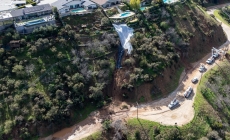-
SpaceX to Launch Intuitive Machines Nova-C Moon Lander: How to Watch - February 15, 2024
-
A portion of Mulholland Drive, damaged by mudslides in winter storms, reopens - May 26, 2024
-
‘Maybe You Don’t Want to Win’ - May 26, 2024
-
Donald Trump Putting Law Enforcement in Danger: Attorney - May 25, 2024
-
Avoid the waters of these 5 L.A. County beaches this holiday weekend, public health officials say - May 25, 2024
-
Bawdy Comedy ‘Anora’ Wins Palme d’Or at Cannes Film Festival - May 25, 2024
-
Map Shows Heat Wave Zone Spread Into Five New States - May 25, 2024
-
Azusa police arrest suspected slingshot-wielding vandal - May 25, 2024
-
Donald Trump Hammers Judge Ahead of Jury Instructions - May 25, 2024
-
Sometimes U.S. and U.K. Politics Seem in Lock Step. Not This Year. - May 25, 2024
SpaceX to Launch Intuitive Machines Nova-C Moon Lander: How to Watch
Another month, another day, another try at the moon.
A robotic lunar lander is scheduled to launch in the early morning hours of Thursday, one day after a technical glitch postponed the first launch attempt. If all goes well, it will become the first American spacecraft to set down softly on the moon’s surface since the Apollo 17 moon landing in 1972.
It is also the latest private effort to send spacecraft to the moon. Earlier attempts have all ended in failure. But the company in charge of the latest effort, Intuitive Machines of Houston, is optimistic.
“I feel fairly confident that we’re going to be successful softly touching down on the moon,” said Stephen Altemus, the president and chief executive of Intuitive Machines. “We’ve done the testing. We’ve tested and tested and tested. As much testing as we could do.”
When is the launch and how can I watch?
The Intuitive Machines lander, named Odysseus, is scheduled to launch at 1:05 a.m. Eastern time on Thursday on a SpaceX Falcon 9 rocket from NASA’s Kennedy Space Center in Florida. About two hours before the launch, NASA and SpaceX both announced that weather continued to be about 90 percent favorable to allow a launch to go forward.
SpaceX and NASA will stream coverage of the launch beginning at 12:20 a.m. Eastern time.
SpaceX announced late on Tuesday that it was postponing a launch attempt on Wednesday morning. The company said in a post on X that the temperature of methane fuel for the lander was “off-nominal.”
If another technical problem or bad weather delays the launch, SpaceX can try again on Friday.
When and where is the landing?
If the launch occurs this week, the landing will be on Feb. 22 near a crater named Malapert A. (Malapert A is a satellite crater of the larger Malapert crater, which is named after Charles Malapert, a 17th-century Belgian astronomer.)
Odysseus will enter orbit around the moon about 24 hours before the landing attempt.
The landing site, about 185 miles from the south pole on the near side of the moon, is relatively flat, an easier location for a spacecraft to land. No American spacecraft has ever landed at the lunar south pole, which is a focus of many space agencies and companies because it may be rich in frozen water.
How big is the spacecraft?
Intuitive Machines calls its spacecraft design Nova-C and named this particular lander Odysseus. It is a hexagonal cylinder with six landing legs, about 14 feet tall and 5 feet wide. Intuitive Machines points out that the body of the lander is roughly the size of an old British phone booth — that is, like the Tardis in the “Doctor Who” science fiction television show.
At launch, with a full load of propellant, the lander weighs about 4,200 pounds.
What is going to the moon?
NASA is the main customer for the Intuitive Machines flight; it is paying the company $118 million to deliver its payloads. NASA also spent an additional $11 million to develop and build the six instruments on the flight:
-
A laser retroreflector array to bounce back laser beams fired from Earth.
-
A LIDAR instrument to precisely measure the spacecraft’s altitude and velocity as it descends to the lunar surface.
-
A stereo camera to capture video of the plume of dust kicked up by the lander’s engines during landing.
-
A low-frequency radio receiver to measure the effects of charged particles near the lunar surface on radio signals.
-
A beacon, Lunar Node-1, to demonstrate an autonomous navigation system.
-
An instrument in the propellant tank that is to use radio waves to measure how much fuel remains in the tank.
The lander is also carrying a few other payloads, including a camera built by students at Embry-Riddle Aeronautical University in Daytona Beach, Florida; a precursor instrument for a future moon telescope; and an art project by Jeff Koons.
Wasn’t there just another American spacecraft headed to the moon?
On Jan. 8, Astrobotic Technology sent its Peregrine lander toward the moon. But a malfunction with its propulsion system shortly after launch prevented any possibility of landing. Ten days later, as Peregrine swung back toward Earth, it burned up in the atmosphere above the Pacific Ocean.
Both Odysseus and Peregrine are part of NASA’s Commercial Lunar Payload Services program, or CLPS. The object of the program is to use commercial companies to send experiments to the moon rather than NASA building and operating its own moon landers.
“We’ve always viewed these initial CLPS deliveries as being kind of a learning experience,” Joel Kearns, the deputy associate administrator for exploration in NASA’s science mission directorate, said during a news conference on Tuesday.
The space agency hopes this approach will be much cheaper, allowing it to send more missions more frequently as it prepares to send astronauts back to the moon as part of its Artemis program.































